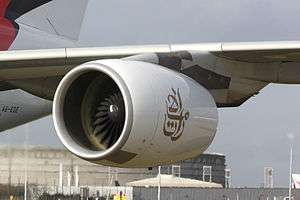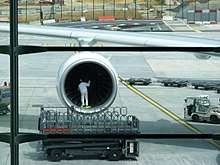Engine Alliance GP7000
The Engine Alliance GP7000 is a turbofan jet engine manufactured by Engine Alliance, a joint venture between General Electric and Pratt & Whitney. It is one of the powerplant options available for the Airbus A380, along with the Rolls-Royce Trent 900.
| GP7000 | |
|---|---|
 | |
| A GP7270 installed on an Airbus A380. | |
| Type | Turbofan |
| National origin | United States |
| Manufacturer | Engine Alliance |
| First run | April 2004 |
| Major applications | Airbus A380 |
| Unit cost | $13.5 million (2006 USD) |
| Developed from | General Electric GE90 Pratt & Whitney PW4000 |
Design and development

Originally intended to power Boeing Commercial Airplanes' cancelled 747-500X/-600X, the engine has since been pushed for Airbus' A380-800 superjumbo. It is built around an 0.72 scale of the GE90-110B/115B core [1] and contains a Pratt & Whitney fan and low-pressure system design.
The competing Rolls-Royce Trent 900 was named as the lead engine for the then-named A3XX in 1996 and was initially selected by almost all A380 customers. However the GE/PW engine increased its share of the A380 engine market to the point where as of September 2007 it will power 47% of the super-jumbo fleet. This disparity in sales was resolved in a single transaction, with Emirates' order of 55 GP7000-powered A380-800s, comprising over one quarter of A380 sales (as of September 2007). Emirates has traditionally been a Rolls-Royce customer. A380 aircraft powered by the GP7000s will have A380-86X model numbers as 6 is the code for Engine Alliance engines. The engine powers an estimated 60% of Airbus A380 in service as reported in 2017.[2]
Ground testing of the engine began in April 2004 and was first flight tested as the number two engine on GE's 747 flying testbed over Victorville, CA in December 2004.[3] The American Federal Aviation Administration certified the engine for commercial operation on January 4, 2006.[4] The engine was ground run for the first time on an A380 on August 14, 2006, in Toulouse.[5] On August 25, 2006, the same aircraft, A380-861 test aircraft (MSN 009), made the first flight of an Engine Alliance powered A380. The flight began and ended at Toulouse and lasted about four hours. Tests were performed on the engines' flight envelope, cruise speed, and handling. A day earlier, the same aircraft performed rejected takeoff tests on the engines.
The Engine Alliance offered the GP7200 for the Airbus A380 passenger and freighter configurations. The GP7270 is rated at 74,735 lbf (332.44 kN) of thrust whilst the GP7277 is rated at 80,290 lbf (357.1 kN). The engine is offered with two ratings appropriate for the various A380 configurations and take-off weights: GP7270 for the 560 tonne variant, and GP7277 for the 590 tonne A380-800 freighter (which was subsequently cancelled by Airbus). In mid-2011 an upgrade was announced which will lead to a cut in weight for each engine by 23 kg (51 lb). The new components come from Volvo Aero.[6]
MTU Aero Engines is a major partner of the programme, with 22.5% share. The German company produces the high-pressure turbine, the low-pressure turbine and the turbine center frame. Safran with 17.5% designs and produces the low-pressure compressor. [7] MDS Aero Support Corporation, a Canadian company, is working hand in hand with MTU to develop next generation test beds.
MDS in joint cooperation is building the facility to test the next version of this engine in France. [8]
Variants
- GP7270 with 332.44 kN (74,740 lbf) of thrust. In use by A380-861 of Air France, Etihad Airways, Korean Air, and Qatar Airways, as well as 90 of the 123 A380s ordered by Emirates[9][10].
- GP7277 with 357.1 kN (80,300 lbf) of thrust. Originally for use on the now-cancelled A380-863F freighter.
Applications
Notable incidents
On 30 September 2017, Air France Flight 66, an Airbus A380 with registration F-HPJE, suffered an uncontained engine failure during flight where the entire fan module (blades and disc) and nose cowl on its number-four GP7270 engine separated from the engine. The aircraft was flying from Paris Charles de Gaulle Airport to Los Angeles International Airport.[11] The aircraft was safely diverted to CFB Goose Bay, Canada.[12] To repatriate the stranded jet, the damaged engine would be replaced and sent back to GE's workshop at Cardiff; a replacement engine would be placed in the same position to balance the weight but not operable.[13] The French accident investigation agency BEA, which is conducting the investigation into the incident, released photos of the first engine fan, fan hub and cowling parts being recovered in Greenland.[14][13][15]
Specifications (GP7270)
General characteristics
- Type: two-spool high-bypass turbofan engine
- Length: 4.92 m (16.1 ft; 194 in) spinner to flange[16]
- Diameter: 3.16 m (10.4 ft; 124 in), fan 2.96 m (9.7 ft; 117 in)
- Dry weight: 6,712 kg (14,797 lb)
Components
- Compressor: 24 swept wide-chord hollow titanium fan blades, 8.8:1 by-pass ratio; five-stage low-pressure axial compressor; nine-stage high-pressure axial compressor
- Combustors: low-emissions single annular combustor
- Turbine: two-stage high pressure turbine, boltless architecture, single crystal blades, split blade cooling and thermal barrier coatings, axial flow; six-stage low-pressure axial flow
Performance
- Maximum thrust: 36,980 kgf, 363 kN, 81,500 lbf
- Overall pressure ratio: 43.9
- Air mass flow: 900 to 1,200 kg/s (2,000 to 2,600 lb/s)
- Thrust-to-weight ratio: 5.197 (assuming 13,400 lbf weight of engine and 70,000 lbf of thrust)
See also
Related development
- General Electric GE90
- Pratt & Whitney PW4000 – High-bypass turbofan aircraft engine
Comparable engines
Related lists
- List of aircraft engines – Wikimedia list article
References
- "GE90-115 paves way for 'GEN X' Sonic Cruiser development". Flight Global. 2001-12-04. Retrieved 2016-02-14.
- Freed, Jamie (13 Oct 2017). "FAA orders A380 engine inspections after Air France incident". Reuters. Retrieved 13 October 2017.
- "GP7200 Takes to the Skies in First Flight Test" (Press release). GE Aviation. 2004-12-07. Retrieved 2012-06-25.
- "GP7200 Achieves FAA Certification" (Press release). Engine Alliance. 2006-01-04. Retrieved 2012-06-24.
- "Picture: Airbus begins engine runs on Engine Alliance GP7200-powered A380 in Toulouse". Flight Global. 2006-08-15. Retrieved 2012-06-24.
- John Croft (2011-06-22). "PARIS: Engine Alliance cuts another 50 pounds from GP7200". Flight Global. Retrieved 2012-06-24.
- url = http://www.mtu.de/fileadmin/EN/7_News_Media/2_Media/Brochures/Engines/GP7000.pdf
- http://www.afiklmem.com/AFIKLMEM/en/g_page_standard/MediaRelation/BlueLink_10_October2012/BlueLink_10_EngineTestBench.html
- "Record £6bn order for Rolls-Royce". 17 April 2015. Retrieved 20 April 2018 – via www.bbc.com.
- "Orders and deliveries". Airbus. Retrieved 20 April 2018.
- "Incident: France A388 over Greenland on Sep 30th 2017, uncontained engine failure, fan and engine inlet separated". avherald.com. Retrieved 20 April 2018.
- Editorial, Reuters. "Air France flight with engine damage makes emergency landing in Canada". reuters.com. Retrieved 20 April 2018.
- Hepher, Tim (10 Oct 2017). "Damaged A380 to be flown to France to investigate engine blast". Reuters. Retrieved 11 October 2017.
- "First parts of AF66 engine and cowling recovered from Greenland. - ASN News". ASN News. 2017-10-06. Retrieved 2017-10-13.
- AIRBUS A380 F-HPJ Greenland Fan Hub Recovery by GEUS / BEA (June 2019), retrieved 2019-08-13
- https://www.easa.europa.eu/system/files/dfu/20140404_TCDS_IM.E.026_issue04_0.pdf
External links
| Wikimedia Commons has media related to Engine Alliance GP7000. |
- Official site, Engine Alliance
- Official site, GE-Aviation
- Official site, Pratt & Whitney